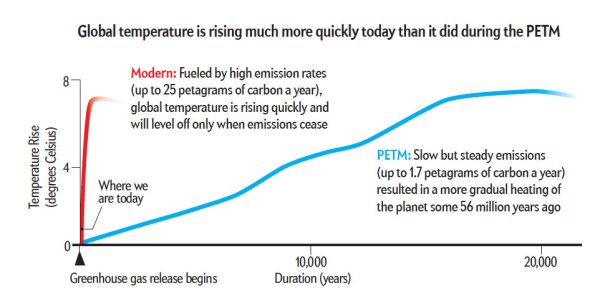New Zealand’s Stuff had a rare reference to climate change with this headline, Carbon emissions highest in 66 million years, since dinosaur age.
Ten Times Faster Than A Hothouse Extinction — Human Carbon Emission is Worst in at least 66 Million Years
“If
you look over the entire … last 66 million years, the only event
that we know of … that has a massive carbon release and happens
over a relatively short period of time is the PETM. We actually have
to go back to relatively old periods. Because
in the more recent past, we don’t see anything [even remotely]
comparable to what humans are currently doing.”
*****
(Annual
human carbon emissions are about 150 times that of all the volcanoes
on the Earth, 10 times faster than a hothouse extinction that
occurred 55.8 million years ago. Image source: La
Rosa Rossa.)
22
March, 2016
Let’s
be very clear. The human fossil fuel emission is outrageous and
unprecedented on geological timescales. An insult the Earth has
likely never seen before. For the pace at which we are emitting
carbon into the atmosphere is just flat out insane. We’ve known
this for some time because the best of science can’t find any time
in all of Earth’s geological history that produces a rate of
atmospheric carbon accumulation equal to the one that’s happening
now.
However, a
new study recently published in Nature now
sheds more light on this rather difficult and scary topic. But in
order to find an event that is even remotely comparable to the
current human greenhouse gas emission, scientists had to look far
back into deep time. All the way back through a period when the last
of the Dinosaurs were dying off about 55-66 million years ago.
During
this time we find evidence of the most recent Hothouse Mass
Extinction Event in the geological record. We call this event the
Paleocene-Eocene Thermal Maximum or PETM because it’s an extreme
period of rapid warming that occurred at the boundary between these
two periods of Earth History about 55.8 million years ago.
The
PETM Hothouse Extinction
The
PETM was pretty amazingly bad.
It set off a mass extinction in the oceans which wiped out half of
all shellfish through the varied impacts of anoxia, acidification and
coral bleaching. Its heat forcing was enough to completely reverse
ocean circulation and set up a stratified ocean state. Peatlands
and forests went up in mass conflagrations.
Terrible insect plagues swept the globe. The related extreme surface
temperatures forced a mass poleward migration and widespread genetic
alteration of mammals which were eventually reduced to dwarfism.
(Earlier
studies estimated PETM emissions rates in the range of 1.7 billion
tons of carbon per year. A
new Nature study finds
PETM emissions to be even lower at 1.1 billion tons of carbon per
year. This compares to a current human emission of 10 billion tons of
carbon per year. A rate of emission that could jump to as high as 25
billion tons of carbon per year by mid Century unless fossil fuel use
is curtailed. It’s worth noting that the ‘slow but steady’ PETM
emissions above represent one of the most rapid periods of warming in
Earth’s geological history. Image source: Climate
Crocks.)
It
was a rough and wrenching time of change and difficulty for pretty
much all of life on Earth. But
what the new study finds and confirms is
that the rate of atmospheric carbon accumulation during that
extinction period, though enough to cause seriously dramatic climate
shifts, was much, much slower than what we see now.
A
Human Hothouse Extinction Would be Far Worse
On
average, over
the PETM extinction event, rates of atmospheric carbon accumulation
were found to be in the range of about 1.1 billion tons per year.
By comparison, human carbon emissions during 2014 were about ten
times this level at around 10 billion tons of hothouse gas hitting
the atmosphere. As such, the new study finds that
the velocity of the human carbon emission exceeds that of the
Paleocene-Eocene hothouse extinction event by an order of
magnitude (x10).
Study
authors found that the large carbon emission occurred over the course
of about 4,000 years.
This spike in atmospheric carbon coincided with an approximate 5
degree Celsius spike in global temperatures in the 4,000 to 12,000
year time period. This implies a rate of warming of at most around
0.12 degrees Celsius every 100 years (or as little as 0.04 degrees
Celsius per Century). Other
estimates put the rate of PETM warming at around 0.025 C per Century.
Expected human warming between 1 and 5 degrees Celsius this Century
is therefore about 10 to more than 200 times faster than during the
PETM extinction event given the best available current scientific
evidence.
Such
high rates of atmospheric carbon accumulation and related global
heating risk generating an event that is outside of any geological
context that scientists might use to predict the human warming
event’s severity.
“It
means we don’t have a really good analog in the past for the
massive amount of carbon we’re releasing,” Zeebe said to National
Geographic.
“Even if we look at the PETM and say the transition to a warmer
climate may have been relatively smooth, there’s no guarantee for
the future.”
In
other words, if you’re adding carbon to the atmosphere at a rate
ten times faster than during one of the most remarkable warming
events in Earth’s History, then the pace of wrenching geophysical
changes and the extinction pressure on organisms is going to be far,
far greater. Something that is certainly worse than the PETM and
that may
even exceed the terrible losses seen during the Permian Mass
Extinction if
we don’t get a handle on our fossil fuel emissions soon.
Links:
Hat
tip to DT Lange
Hat
tip to Colorado Bob





No comments:
Post a Comment
Note: only a member of this blog may post a comment.